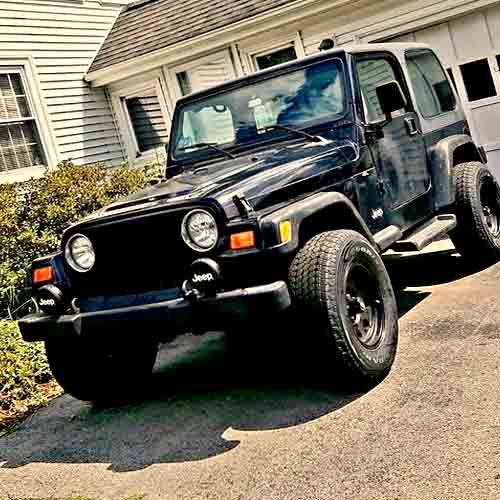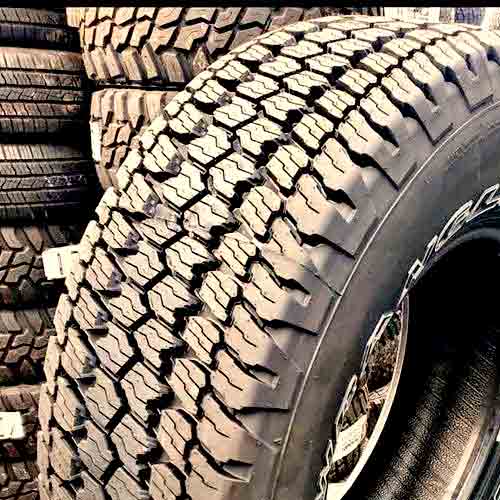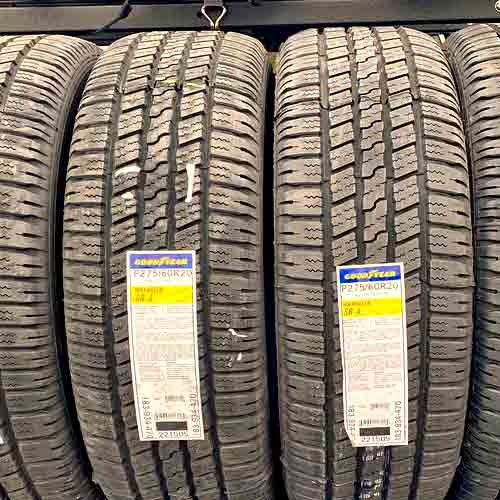Whether you’re looking to take your truck or SUV off-road or simply want a more favorable driving experience, the Goodyear Wrangler AT/S and the Wrangler SR-A are both excellent options. They are packed with a lot of tread features, designed to deliver a great balance between highway grip and off-road traction.

As a tire engineer, my testing show that the Goodyear Wrangler AT/S is although lacking overall on pavements, relatively, it’s off-road traction has the upper hand. Whereas the Goodyear SRA supplies superior on-road performance, in terms of grip, comfort, fuel economy and tread life.
Specs of Sizes
On the other hand, the Goodyear Wrangler A/TS comes in 15 to 20 inches with following specs:
- Speed ratings: R and S.
- Load ratings: SL, C, D and E.
- Weight range: 30 to 60 lbs.
- Tread depth: 13 to 16/32″.
- Ratings: No 3PMSFR.
- Warranty: None.
The Wrangler SRA on the other hand, has following.
- Sizes: 15 to 20 inches rims.
- Speed ratings: R, S and T.
- Load ratings: SL, XL, C, D and E.
- Weight range: 26 to 52 lbs.
- Tread depth range: 11 to 16/32″.
- Tread warranty: 50k (for non-LT sizes only).
- Winter ratings: None.
Tread Features
Starting form the Goodyear Wrangler A/TS, the tire is slightly more aggressive in comparison.

So this tire gives you a mixture of both on and off-road traction.
Out of which the traction on rugged terrains comes form the shoulder blocks, as these have a lot more biters and have an open design, comparatively.
With the wider outer circumferential channels they make, combined with multiple off-set edges and notches, they get to grip at multiple angles.
And where off-road traction is achieved by these lugs, the middle ones yield traction on smooth pavements.
They are pretty packed up together, and have ridges in between, providing more surface area of their rubber to be in contact with the highways, providing grip, especially while moving/rolling straight.
On the other side, the Goodyear SRA is a less aggressive option. So it makes sense why its an all-season tire.

It comes with 3 continuous running ribs in the middle, forming 4 longitudinal grooves.
The middle most rib has blocks with zigzag lateral grooves (forming in-groove notches). Moreover, they also carry more sharp edges to them, along with off-sets.
The surrounding ribs have more of a squared geometry of blocks. They don’t carry as many biting edges, but have similar sipes.
Moving towards shoulders, the blocks are the biggest here. They are elongated, have minimal edges along with chamfered sides, and carry similar siping pattern as seen in the middle.
Off Road Traction
Off-road, things can be easily explained by splitting down to the following terrain types.
Muddy Terrains
Mud needs room to leave out the tire, otherwise it’s sticky nature would clog up the tread and lose all gripping capabilities.
That’s why with a more voided structure on Goodyear A/TS, the tire gets to be better at it.
The Goodyear SRA on the other hand, is very crowded with lugs, and gets packed with mud very quickly, as it does not allow for lateral mud evacuation with it’s longitudinally aligned ribs with very small gaps in between.
On Rocks
On rocks, you need tires capable of gripping form all directions. And so with directional orientation of lugs, although you can’t expect too much out of both these tires, you still have a better shot with Goodyear Wrangler ATS.
The tire offers bigger groove mouth, especially form the shoulders, and supplies you with relatively balder structure, so lugs can bite in to rocky surface with better efficacy.
Moreover, it’s full depth sipes can split open the blocks, adding to the overall bite, the tire offers.
Sandy Dunes
Although there’s a minor difference between both tires, the Goodyear SRA with lighter overall weight supplies superior sand grip.
Moreover, its relatively more pliable tread compound also molds better with the sand, when you lower the tire’s air pressure.
The Goodyear A/TS on the other hand, has a stiffer rubber, and sides are more biting, so it’s prone to digging, relatively.
Highway Performance
To get their highway performance evaluated, I tested these tires for their traction, both directionally and laterally, as well as steering feedback.
Dry Grip
Directional grip represent a tire’s traction on a straight road, and it depends on the central section of the tread.
That’s why with a more packed up structure, the Goodyear SRA comes out on top, with it’s shorter braking distances (which measures directional grip, directly).
The Goodyear A/TS, in comparison, is more voided, and it’s central most section forms a (longitudinal) groove (instead of rubber area).
Moreover, its ribs of sides also have wider lateral tread voids. So naturally this tire can’t offer similar gripping efficacy, as the SRA.
Dry Handling
Dry handling although also has to do with the tire’s footprint as well, it also highly depends on the steering sensitivity of a tire.
The Goodyear SRA not only offers a more closed up shoulder lugs, with a blocky design, but you also get reinforced foundational supports underneath them.
This allows for superior stability as the tire curves, resulting in faster steering response.
The Goodyear Wrangler A/TS on the other hand, although has a harder tread compound, and it’s shoulder lugs are connected to each other on sidewalls (see the tread appearance section above), the tire still lacks with wider tread voids between them, and missing rubber foundations underneath.
So they are still susceptible to bend more when a tire corners, resulting in slower handling times.
Wet Traction
Wet traction has always been very challenging for the all terrain tires, though some on-road oriented ones, like these, still do good enough.
And out of them, my tests show that the Goodyear SRA has the upper hand, with it’s interlocking full depth sipes.
With this wave-like siping pattern, the slits don’t get stiffen up with the tire’s maneuverability, as they easily flex to create proper suction for the water particles coming underneath.
(BTW, this is how sipes work, they soak up water in their slits).
The Goodyear ATS on the other side, not only lacks in providing an interlocking siping structure, but with it’s harder tread compound, its sipes are further rendered in-effective.
Fuel Consumption
Fuel is dependent on Rolling resistance, which gets highly shaped by the tire’s structure (which includes tread composition, and weight, as well).
Having said that, it can be seen why the Goodyear SRA is relatively better here, with it’s lighter weight and closed up tread blocks.
The closeness of the lugs allow for better distribution of the weight, and the longitudinal streamlining of the ribs supply transition of the weight as the tire rolls.
In comparison, the blocks on Goodyear A/TS are more independent, and they bend more with the tire’s movement, causing energy loses, and limited fuel economy.
Tread Life
Tread life also depends on the rollings resistance (though it also depends on tread depth, but both tires have similar, across all sizes).
So it makes sense why the Wrangler ATS does not comes with any treadwear warranty, whereas its counterpart gives you 50k miles.
Like explained above (in the fuel section), each of the lugs on Goodyear SRA gets to bear less weight pressure on itself, they rub off the surface with smaller force, and so burning rate is also slower, in this tire’s case.
Ride Quality
There are two parts of this puzzle, noise, and feel of the ride.
In terms of noise, we have a clear winner, the Goodyear SRA. The tire is on average 3 decibels quieter (tested in 20, 30 and 50 mph).
Moreover, since the tire also features a softer tread compound, it soaks up the imperfections (of the road) much more effectively, in comparison.
The Goodyear Wrangler ATS on the other hand is too voided towards outer edges, allowing more air to come in and strike the walls around, generating greater noise.
Moreover, it’s stiffer rubber also can’t dampen the bumps off the road.
Winter Traction
Both tires lack in providing 3PMSF ratings, but their all season tread compound, are still capable of getting the job done.
And with a minor difference, the Goodyear A/TS takes the lead comparing both tires. This is because the tire delivers superior snow holding abilities.
Basically for maximum winter performance, you need minimum rubber to road contact, and this tire with it’s voided structure grabs up snow particles in its tread voids, and makes snow to snow contact instead.
This yields better friction, as snowflakes are really sticky for each other.
Take Home Points
Goodyear Wrangler AT/S, as it comes with a relatively more open tread design, supplies you with better off-road performance, compared to highways.
Though it’s winter traction is still better off the two.
Goodyear Wrangler SR-A on the other hand, features superior dry and wet grip and supplies you with faster steering response. Moreover, the tire is also great in the comfort department, features a more fuel efficient structure, and gives out longer tread life.